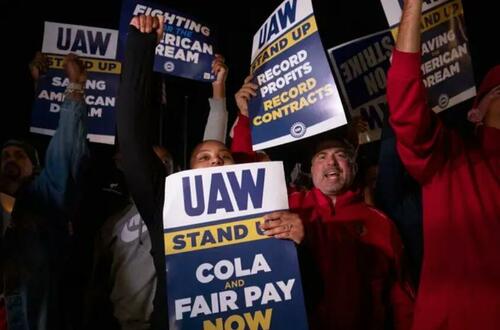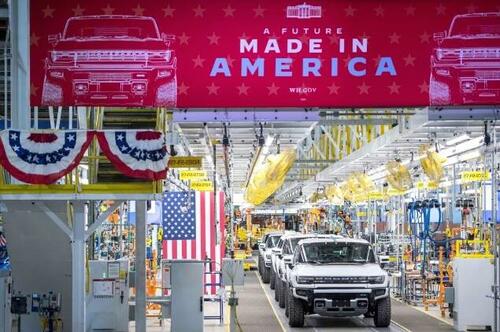
Authored by Anders Corr via The Epoch Times,
The United Auto Workers (UAW) went on strike on Sept. 15. The strike affected the “big three” in Detroit—General Motors, Ford, and Stellantis, maker of the Jeep. The union wants to increase average labor costs from $65 per hour, including benefits, which is already above market rates. Nonunionized Tesla, for example, pays “just” $45 per hour in labor, considering the cost of benefits.

The UAW's demands would roughly double labor costs and, according to management, make the companies unviable. Where will the workers go when the automakers go bankrupt, further mechanize their assembly lines, or move yet more production to China?
Many workers in these companies who aren't on strike are already getting fired. Striking unions attempt to inflict maximum pain on their own companies with as little effort and expenditure as possible. The companies are forced to let go of misguided workers, who they can’t keep busy because other misguided workers on whom they depend are striking. All the strikers and fired UAW workers are getting paid from union funds that came from dues imposed on workers, whether they like it or not. They're getting paid by the union to halt production.
This ludicrous practice introduces massive inefficiencies into U.S. manufacturing, yet Americans over the decades have gotten used to the deadweight it attaches to the economy.
The supply chain chaos of the latest strike is purposefully engineered by the UAW, which keeps management guessing which factory will close next. Downstream and upstream workers, including from hundreds of other companies, depend on a reliable supply chain and are made redundant by the UAW’s actions as soon as the factory can't produce vehicles and supply them to paying customers.
Shareholders in these companies have felt more pain than strikers in recent months, with shares of Stellantis falling by more than 7 percent and shares of Ford and GM falling by more than 20 percent. Compare that to rising inflation, which is less and hits the pocketbooks of both shareholders and workers.
Yet union bosses want to grab even more value from shareholders in a manner that's ultimately a small win and big loss for not only the workers and companies, respectively, but also for the entire economy. What a tiny percentage of U.S. unionized auto workers hope to gain in increased wages, shareholders lose in multiples, and Americans as a whole lose in our market’s competitiveness.
Investors prefer to invest in countries where they aren’t compelled to share profits when times are good. That’s why investors risk their capital. With no significant upside, investors will keep their money in lower-profit but more reliable investments such as bonds, a preference that, if widespread, would impoverish not only the auto industry but all of the American industry. It's an inefficient form of investing and removes the critical element to the economic growth of risk-takers as decision-makers with skin in the game.
Shareholders aren't all billionaires. In fact, 158 million Americans own shares in companies—about three-quarters of all adults. As should be clear from those numbers, most shareholders are regular folks, and those regular folks are getting fleeced by the union (full disclosure: This author is a regular guy who holds GM shares).
The problem isn't just with the unions. The problem is with our politicians, who can't stand up to the unions, or they get voted out of office. That's why both Republicans and Democrats avoid angering unions, and why they silently endure strikes that debilitate not only the affected companies but the entire economy.

A general view of GMC Hummer EVs is (more…)


 Bitcoin
Bitcoin  Ethereum
Ethereum  Tether
Tether  TRON
TRON  Stellar
Stellar  Litecoin
Litecoin  Monero
Monero  Ethereum Classic
Ethereum Classic  VeChain
VeChain  Maker
Maker  Tezos
Tezos  Zcash
Zcash  NEO
NEO  Dash
Dash  0x Protocol
0x Protocol  Decred
Decred  NEM
NEM  Ontology
Ontology  Lisk
Lisk  OMG Network
OMG Network  Bitcoin Gold
Bitcoin Gold